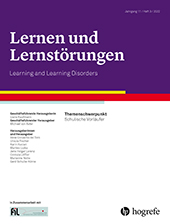Literatur
(2017). Psychophysical evidence for the number sense. Philosophical Transactions of the Royal Society. Series B, Biological sciences , 373 (1740), 20170045.
(2022). Screening-Verfahren zur Prognose von Rechenschwierigkeiten in der Grundschule. Lernen und Lernstörungen , 11 , 125–138.
(2017). A random-matrix theory f the number sense. Philosophical Transactions of the Royal Society B , 373 : 20170253.
(2009). Early math matters: Kindergarten number competence and later mathematics outcomes. Developmental Psychology , 45 , 850–867.
(2016). Which preschool mathematics competencies are most predictive of fifth grade achievement? Early Child Research Quarterly , 36 , 550–560.
(2016). The neural code for number. Nature Reviews Neuroscience , 17 , 366–382.
OECD (2011) Inclusion of Students with Disabilities in Tertiary Education and Employment, Education and Training Policy, OECD Publishing, Paris , https://doi.org/10.1787/9789264097650-en.(2005). Does Numeracy Matter More? National Research and Development Centre for Adult Literacy and Numeracy : London, UK.
(2022). Feinmotorik, Fingergnosie und frühe mathematische Fähigkeiten: Ein Überblick. Lernen und Lernstörungen , 11 , 139–157.
(2016). Magnitude knowledge: The common core of numerical development. Developmental Science , 19 , 341 361.
(2022). Cliffhanger als gewinnbringendes Stilmittel bei der Leseförderung? Lernen und Lernstörungen , 11 , 158–166.
(2013). The contribution of general cognitive abilities and number abilities to different aspects of mathematics in children. Journal of Experimental Child Psychology , 116 , 139–156.
(2022). Predicting math ability using working memory, and neurophysiology in children and adults. Brain Sciences , 12 : 550.
(2021)
Rechenstörungen im Kindes- und Jugendalter . In Fegert J. (Hrsg.) Psychiatrie und Psychotherapie des Kindes- und Jugendalters . Springer Reference Medizin. Springer, Berlin, Heidelberg.(2022). Belastungen durch Fernlehre und psychische Gesundheit von Studierenden während der COVID-19-Pandemie. Lernen und Lernstörungen , 11 , 167–179.



